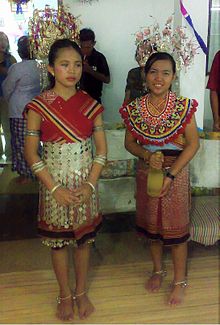Ethnic groups[edit]
Sarawak has more than 40 sub-ethnic groups, each with its own distinct language, culture and lifestyle. Cities and larger towns are populated predominantly by Malays, Melanaus, Chinese, Indians, and a smaller percentage of Ibans and Bidayuhs who have migrated from their home villages to look for employment.
Generally, Sarawak has seven major ethnic groups namely Iban, Chinese, Malay, Bidayuh, Melanau, Orang Ulu, and "others". Several more minor ethnics which do not belong to any of these seven major ethnic groups are Kedayan, Javanese, Bugis, Murut, and Indian. Unlike Indonesia, the term Dayak is not officially used to address Sarawakian's native ethnicity.
Iban[edit]
Main article: Iban people
The Ibans comprise the largest percentage (almost 30%) of Sarawak's population.[17] Iban is native to Sarawak and Sarawak has the highest number of Ibans in Borneo.
The large majority of Ibans practise Christianity. However, like most other ethnic groups in Sarawak, they still observe many of their traditional rituals and beliefs. Sarawak celebrates colourful festivals such as the Gawai Dayak (harvest festival), Gawai Kenyalang (hornbill, or the god of war festival), penuaian padi and Gawai Antu (festival of the dead).
Chinese[edit]
Main article: Malaysian Chinese
Chinese pioneers first came to Sarawak as traders and explorers in the 6th century. Today, they make up 24% of the population of Sarawak[17] and consist of communities built from the economic migrants of the 19th and early 20th centuries. They are classified as a non-Bumiputera ethnic group, despite bearing the largest contribution and hardship towards the development of Sarawak since the early 19th century.
The Sarawak Chinese belong to a wide range of dialect groups, the most significant being Foochow, Hakka, Hokkien, Teochew, Hainanese, and Puxian Min. The Chinese maintain their ethnic heritage and culture and celebrate all the major cultural festivals, most notably the Chinese New Year and theHungry Ghost Festival. The Sarawak Chinese are predominantly Buddhists.
Ethnic Chinese in Sarawak were encouraged to settle because of their commercial and business acumen. The biggest dialect group is the Hokkien; many originated from Jinmen and Taiwan, Republic of China and Xiamen in China. The Hakka and Cantonese represent a minority of the Chinese population. Despite their small numbers, the Hokkien have a considerable presence in Sarawak's private and business sector, providing commercial and entrepreneurial expertise and often operating joint business ventures with Malaysian Chinese entreprises.[18]
There are number of Chinese settled down in Sarawak between the years 1911–1949 after the Nationalist led-Kuo Min Tang lost in civil war in 1949 between against Communist Party of China. Most of the Nationalist refugees or Neutral fled from Mainland China.[19][20]
In 1963, when Sarawak helped Malaya to form Malaysia, most of them automatically gained the Citizenship of Malaysia despite of having the Kuo Min Tang Republic of China Citizenship.[21]
Malay[edit]
Main article: Malaysian Malays
The Malays make up 23% of the population in Sarawak.[17] They mostly populate the southern region and urban areas of Sarawak.
Melanau[edit]
Main article: Melanau
The Melanaus have been thought to be amongst the original settlers of Sarawak [22]. They make up 6% of the population in Sarawak.[17]
Today most of the Melanaus community profess Islam and Christianity, though they still celebrate traditional animist festivals such as the annual Kaul Festival.
Bidayuh[edit]
Main article: Bidayuh
Concentrated mainly on the West end of Borneo, the Bidayuhs make up 8% of the population in Sarawak.[17]
The Bidayuhs speak a number of different but related dialects. Some Bidayuhs speak either English or Sarawak Malay as their main language. While some of them still practise traditional religions, the majority of modern-day Bidayuhs have adopted the Christian faith. Another ethnic associated to Bidayuh is Salako, classified as Bidayuh by the Malaysian government for political convenience.
Orang Ulu[edit]
Main article: Orang Ulu
Orang Ulu is an ethnic group in Sarawak. The various Orang Ulu ethnics together make up roughly 6% of Sarawak's population. The phrase Orang Ulumeans upriver people and is a term used to collectively describe the numerous tribes that live upriver in Sarawak's vast interior. Such groups include the major Kenyah and Kayan people, and the smaller neighbouring groups of the Kajang, Kejaman, Punan, Ukit, and Penan. Nowadays, the definition also includes the down-river tribes of the Lun Bawang, Lun Dayeh, "mean upriver" or "far upstream", Berawan, Saban as well as the plateau-dwelling Kelabits. Orang Ulu is a term coined officially by the government to identify several ethnics and sub-ethnics who live mostly at the upriver and uphill areas of Sarawak. Most of them live in the district of Baram, Miri, Belaga, Limbang, and Lawas.
A vast majority of the Orang Ulu tribe are Christians but traditional religions are still practised in some areas.
Some of the major tribes making up the Orang Ulu group include:
Others[edit]
Other minority ethnic groups residing in Sarawak are the Kedayan ethnic groups and also the Punan Bah people (in fact is a collective of obscure and unaccounted ethnic communities grouped together as a single ethnic entity), and also non-Bumiputera ethnic groups, which are the Indian and Eurasian.
The Kedayan are an ethnic group residing in parts of Sarawak. The Kedayan language is spoken by more than 37,000 people in Sarawak, with most of the members of the Kedayan community residing in Lawas, Limbang, Miri, and Sibuti areas. Unlike its Peninsular counterpart, Sarawakians of Indian descent are small in number and have assimilated very well to the other communities. Eurasians continues to be the smallest among the minority ethnic groups in Sarawak, mostly due to assimilation and interracial marriages. The Punan Bah communities are usually located in areas that encompass the borders of Sarawak, Sabah, Brunei, and Indonesia. More studies need to be carried out about them, as they are one of the lesser known group in the state.




No comments:
Post a Comment